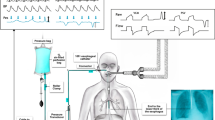Abstract
Objective.Pulse oximetry (SpO2) is the noninvasivestandard for monitoring arterial oxygen saturation in patients undergoinganesthesia, but is subject to external interference by motion artifact,peripheral vasoconstriction, and low cardiac output. We hypothesized thatoximetry signals could be acquired from the esophagus when peripheral pulseoximetry is unobtainable. Therefore, we tested an esophageal stethoscope whichincorporates transverse oximetry photodetectors and emitters in patientsundergoing coronary bypass surgery. Methods.Immediately afterinduction of general anesthesia in 10 coronary artery bypass (CABG) patients,Criticare and Nellcor digital probes were positioned on the left hand,concurrent with placement of an esophageal SpO2 probe. A computerrecorded 5,910 matched oximetry signals every 15 sec during an average of 2.5hrs. All SpO2 measurements were before, and immediately afternon-pulsatile, hypothermic cardiopulmonary bypass. Data represent thepercentage (median value [range]) of the total monitored time thata SpO2 value was displayed. Results.The Nellcor (99.8%,range 6.5–100%) and Criticare (99.7%, range 36.6–100%) acquiredand displayed saturation signals more frequently (p= 0.003) than theesophageal monitor (75.3%, range 42.1–95.8%). The two standard digitaloximeters had a mean difference of 0.9%, with a standard deviation of thedifferences of 0.9. The esophageal probe had a mean difference of −5.2%and −4.8%, with standard deviation of differences of 8.0 and 7.7(compared to the Nellcor and Criticare monitors, respectively). Asecond-generation prototype shielded from electrocautery interference wastested in an additional 4 patients. The shielded prototype displayed signalsmore frequently (96.7%, range 68.4–100%) than the original esophagealprototype. Conclusions.Digital pulse oximetry failure is common inCABG patients, probably because of marginal cardiac output and peripheralvasoconstriction associated with hypothermia. Our study could not confirm thatesophageal technology, which utilizes the esophagus as a site oftransflectance oximetry, was superior to conventional digital pulse oximetry.
Similar content being viewed by others
REFERENCES
Eichhorn JH, Cooper JB, Cullen DJ, Maier WR, Philip JH, Seeman RG. Standards for patient monitoring during anesthesia at Harvard Medical School. JAMA 1986; 256: 1017-1020
Eichhorn JH. Pulse oximetry as a standard of practice in anesthesia. Anesthesiology 1993; 78: 423-426
Alexander CM, Teller LE, Gross JB. Principles of pulse oximetry:Theoretical and practical considerations. Anesth Analg 1989; 68: 368-376
Costarino AT, Davis DA, Keon TP. Falsely normal saturation reading with the pulse oximeter. Anesthesiology 1987; 67: 830-831
Moller JT, Pedersen T, Rasmussen LS, Jensen PF, Pedersen BD, Ravlo O, Rasmussen NH, Espersen K, Johannessen NW, Cooper JB, Gravenstein JS, Chraemmer-Jørgensen B, Wiberg-Jørgensen F, Djernes M, Heslet L, Johansen SH. Randomized evaluation of pulse oximetry in 20,802 patients: I. Design, demography, pulse oximetry failure rate, and overall complications rate. Anesthesiology 1993; 78: 436-444
Moller JT, Johannessen NW, Espersen K, Ravlo O, Pedersen BD, Jensen PF, Rasmussen NH, Rasmussen LS, Pedersen T, Cooper JB, Gravenstein JS, Chraemmer-Jørgensen B, Djernes M, Wiberg-Jørgensen F, Heslet L, Johansen SH. Randomized evaluation of pulse oximetry in 20,802 patients: II. Perioperative events and post-operative complications. Anesthesiology 1993; 78: 445-453
Langton JA, Hanning CD. Effect of motion artifact on pulse oximeters: Evaluation of four instruments and finger probes. Br J Anaesth 1990; 65: 564-570
Palve H, Vuori A. Pulse oximetry during low cardiac output and hypothermia states immediately after open heart surgery. Crit Care Med 1989; 17: 66-69
Jensen LA, Onyskiw JE, Prasad NG. Meta-analysis of arterial oxygen saturation monitoring by pulse oximetry in adults. Heart Lung 1998; 27: 387-408
Reich DL, Timcenko A, Bodian CA, Kraidin J, Hofman J, DePerio M, Konstadt SN, Kurki T, Eisenkraft JB. Predictors of pulse oximetry data failure. Anesthesiology 1996; 84: 859-864
Freund PR, Overand PT, Cooper J, Jacobson L, Bosse S, Walker B, Posner KL, Cheney FW. A prospective study of intraoperative pulse oximetry failure. J Clin Monit 1991; 7: 253-258
Borum SE. The successful use of transesophageal pulse oximetry in a patient in whom peripheral pulse oximetry was unobtainable. Anesth Analg 1997; 85: 514-516
Jobes DR, Nicolson SC. Monitoring of arterial hemoglobin oxygen saturation using a tongue sensor. Anesth Analg 1988; 67: 186-188
Bland JM, Altman DG. Statistical methods for assessing agreement between two methods of clinical measurement. Lancet 1986; 1: 307-310
Prielipp RC, Kelly JS, Roy RC. Use of esophageal or precordial stethoscopes by anesthesia providers: Are we listening to our patients? J Clin Anesthesia 1995; 7: 367-372
Neff TA. Routine oximetry. A ¢fth vital sign? Chest 1988; 94: 227 (Editorial)
Takatani S. Toward absolute re£ectance oximetry: I. Theoretical consideration for noninvasive tissue reflectance oximetry. Adv ExpMed Biol 1989; 248: 91-102
Cheung PW, Takatani S, Ernst EA. Multiple wavelength re£ectance oximetry in peripheral tissues. Adv Exp Med Biol 1977; 94: 69-75
Sheridan RL, Prelack KM, Petras LM, Szyfelbein SK, Tompkins RG. Intraoperative re£ectance oximetry in burn patients. J ClinMonit 1995; 11: 32-34
Elchalal U, Weissman A, Abramov Y, Abramov D, Weinstein D. Intrapartum fetal pulse oximetry: Present and future. Int J Gynaecol Obstet 1995; 50: 131-137
Keller C, Brimacombe J, Agro F, Margreiter J. A pilot study of pharyngeal pulse oximetry with the laryngeal mask airway: A comparison with ¢nger oximetry and arterial saturation measurements in healthy anesthetized patients. Anesth Analg 2000; 90: 440-444
Kurth CD, Steven JM, Swedlow D. New frontiers in oximetry. AmJ Anesthesiol 1996; 23: 169-175
Author information
Authors and Affiliations
Rights and permissions
About this article
Cite this article
Prielipp, R.C., Scuderi, P.E., Hines, M.H. et al. Comparison of a Prototype Esophageal Oximetry Probe with Two Conventional Digital Pulse Oximetry Monitors in Aortocoronary Bypass Patients. J Clin Monit Comput 16, 201–209 (2000). https://doi.org/10.1023/A:1009941610320
Issue Date:
DOI: https://doi.org/10.1023/A:1009941610320




